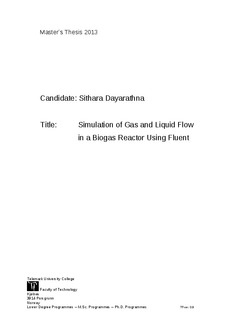| dc.contributor.author | Dayarathna, Sithara | |
| dc.date.accessioned | 2015-09-18T12:03:29Z | |
| dc.date.accessioned | 2017-04-19T13:18:08Z | |
| dc.date.available | 2015-09-18T12:03:29Z | |
| dc.date.available | 2017-04-19T13:18:08Z | |
| dc.date.issued | 2015-09-18 | |
| dc.identifier.citation | Dayarathna, S. Simulation of gas and liquid flow in a biogas reactor using Fluent. Master thesis, Telemark University College, 2013 | |
| dc.identifier.uri | http://hdl.handle.net/11250/2439032 | |
| dc.description.abstract | Anaerobic Digestion (AD) is a popular secondary treatment method to handle biological wastes in sewage and wastewater treatment plants due to its multiple benefits apart from the waste reduction. One of the biogas reactors at VEAS, a large scale sewage treatment plant located at Oslo area has been focused on this study. CFD simulations have been used to simulate the gas and liquid flow fields in the reactor in order to investigate the influence of certain boundary conditions and others factors on the gas and liquid flow characteristics and to provide recommendation to improve the performance of the reactor. Commercial CFD software, ANSYS FLUENT 13.0 has been used for the simulations and GAMBIT 2.4.6 version, a preprocessor to FLUENT has been used to generate the problem geometry and computational mesh. Euler-Euler approach was used as the general multiphase model and liquid and biogas phases were assumed as water and air respectively. Transient simulations were performed with different gas bubble sizes of 1 mm, 5 mm and 10 mm, different inlet velocities of 1.2 m/s and 0.6 m/s and with the presence of a source term for the gas phase. In addition, the existing gas distribution arrangement at the VEAS was also simulated to compare the gas and liquid flow characteristics. The results from the simulation demonstrated a similar flow pattern for 5 mm and 10 mm bubble sizes. Considering the stability of the system, the 10 mm bubble size showed a faster convergence at each time step than the other cases and achieved rather stable flow pattern in a shorter period of time. The low inlet gas velocity case of 0.6 m/s showed a poor liquid velocity distribution compared to that of 1.2 m/s inlet gas velocity case. Inclusion of the source term does not reflect any significant change in the liquid flow fields. The existing gas distribution arrangement at VEAS which uses only 5 pipes at a time showed a different liquid and gas velocity profiles and liquid recirculation patterns. A bulk liquid motion towards the gas inlets were identified in this arrangement while the initial gas distribution arrangement displayed a much better recirculation of liquid throughout the whole liquid volume. | |
| dc.language.iso | eng | |
| dc.publisher | Høgskolen i Telemark | |
| dc.subject | Biogas reactor | |
| dc.subject | CFD simulation | |
| dc.subject | FLUENT | |
| dc.subject | Euler-Euler approach | |
| dc.subject | Gas liquid flow | |
| dc.subject | Bubble size | |
| dc.subject | Velocity vectors | |
| dc.subject | liquid recirculation | |
| dc.title | Simulation of gas and liquid flow in a biogas reactor using Fluent. | |
| dc.type | Master thesis | no |
| dc.description.version | Published version | |
| dc.rights.holder | © Copyright The Author. All rights reserved | |
| dc.subject.nsi | 562 | |
